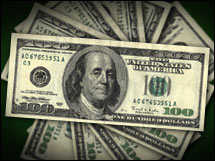|
Inflation report may keep Fed at bay Producer Price Index up much less than forecast as prices excluding food and energy show surprise decline in July. NEW YORK (CNNMoney.com) -- The Federal Reserve's pause was looking more and more like a halt Tuesday, as the first post-Fed meeting inflation reading showed price pressures well in check. Prices paid at the wholesale level increased at a much slower pace in July, according to the government report that showed prices outside of food and energy unexpectedly decreasing.
Economists cautioned it was too soon to say the Fed was finally done with course of rate hikes, which started in June 2004 and continued until it left rates unchanged at the Aug. 8 meeting. There will be at least a half dozen other inflation measures between now and the Sept. 20 meeting, including the Consumer Price Index report set to be released Wednesday. But many economists also said Tuesday's report was a good one for those hoping for lower inflation pressures and no more rate hikes. The Producer Price Index, the measure of prices paid by businesses, rose only 0.1 percent in July, down from the 0.5 percent rise in June. Economists surveyed by Briefing.com had forecast a 0.4 percent rise in the overall PPI. The so-called core PPI, which strips out often volatile food and energy prices, declined 0.3 percent. Economists had forecast the core PPI would be unchanged from the 0.2 percent rise in June. All inflation reports are getting particular attention from investors and economists now, in the wake of the Fed's policy statement last week that it would consider future economic readings in deciding whether to resume its course of rate hikes. "I'm not likely to say inflation is dead, but this definitely does show it's a little more under control," said economist Jason Schenker of Wachovia. "One report does not a trend make. But if we continue to see this in other reports, it'll reinforce the notion the Fed is on hold." U.S. stocks were higher at midday on the PPI report, as investors became even more optimistic that the Fed is now done hiking rates. Treasury prices increased, taking the yield on the 10-year note down to 4.93 percent from 4.99 percent before the report. And at the Chicago Board of Trade, the fed funds futures were pricing in only a 20 percent likelihood of Fed hike at its September meeting, down 32 percent at the close of trading Monday. Still there were some inflationary pressures seen in this report. The overall PPI, which measures prices of finished products, is up a healthy 4.2 percent over the last 12 months, due greatly to a more than one-third increase in the wholesale price of gasoline over that time. Finished consumer goods were up 5.1 percent over that same period. And further up the product pipeline, the prices of crude and intermediate goods showed bigger price increases. Crude product prices rose 6.6 percent and intermediate goods prices were up 8.9 percent. Rich Yamarone, director of economic research at Argus Research, said the PPI report is notoriously volatile and thus of limited useful in predicting what the Fed will do. But he said one of the key readings in the report is the generally little-noticed core intermediate goods index, which measures prices of goods outside of food and energy in the course of the manufacturing process. That rose 0.7 percent in July alone and 7.9 percent year-over-year. "The staggering number of price-pass-along announcements made by companies during earnings season are starting to come through," he said. "Here you see it in this number. We have to worry if the big increases we've seen in crude good prices are going to be passed along to finished stage. The Fed wants to head that off, at least I thought they did before they started flapping these dovish wings." Much of the decrease in core PPI was due to declines in pricing for 3.1 percent one-month decline in the price of light trucks, such as pickups and SUV's, as automakers tried to clear their inventory of 2006 models. There was also a 2.0 drop in the price for home electronics and a 1.8 percent drop in the price of computers. The report came the day before the even more closely watched Consumer Price Index report, which measures prices at the retail level. Unlike the PPI, the CPI also measures prices for services, not just goods, making it somewhat less volatile than the wholesale inflation reading. Economists are forecasting a 0.4 percent rise in the CPI, following a 0.2 percent gain in June, while the core CPI is expected to again show a 0.3 percent increase. "The CPI tomorrow is more important," said David Wyss, chief economist at Standard & Poor's. "Let's see what that says before we get excited. But the core PPI is up only 1.3 percent year over year. That's pretty good. It's certainly encouraging." More on the economy and what it means for you and the markets |
|

